By Eric of DE38 Windsong
Rebuilding the companionway hatch was one of those projects that sounded simple enough, but ended up being a very involved thing taking many months longer than anticipated. Just like with most of the boat, it is only when you take something apart that you realize the full extent of the damage and work to be done.
Sometime when the boat was still put together, I was inside during a rain shower noticing all of the water coming in from various leaks. One that came as a surprise was a steady leak coming through the sliding companionway hatch. I noted it and made sure to investigate it when the time came to focus on that hatch.
The time came and went, and before painting the deck I removed the hatch in its entirety to access the full deck, with the idea that I would do whatever I needed to do to seal up the hatch and make it leak free. When I began to remove the slats that make up the top of the hatch, the horrors beneath were revealed and instead of applying some sealant and calling it a day, I realized I had to rebuild the entire thing.
The pictures and captions below will tell the story:
- Companionway hatch and doors, pre-removal
- Companionway hatch and doors, pre-removal. You can see the wood was in a pretty weathered state.
- Companionway hatch and doors, pre-removal. You can see the wood was in a pretty weathered state.
- Companionway hatch and doors, pre-removal. You can see the wood was in a pretty weathered state.
- Hatch frame after removing the sliding part.
- Hatch back at home ready to be taken apart
- After removing the bungs on the slats and pulling off the frame underneath, the damage was beginning to be revealed. The frame had a lot of rot and a huge crack down the middle of each side, and you can see a big hunk of wood that broke off from the end. All of this was restorable, with good old epoxy.
- However, the real gremlin was revealed when I removed the slats. Underneath the slats and between the formica bottom was what appeared to be a piece of plywood that had completely rotten away. The leak I saw had done some major damage to the plywood supporting the hatch.
- When I first saw this I didn’t even know what i was looking at. Was there some sort of veneer under the slats? It didn’t even make sense. I eventually put it together that it was plywood that had just rotten away.
- Frame under the ply and slats. Lots of cracks and rot, but I committed to restoring the frame so I didn’t have to start from scratch.
- Under it all was a formica panel that was the inside face to the hatch.
- The hatch doors were in decent shape. They needed some mild restoration in areas where wood was damaged, but mostly just needed a cleaning, sanding and finish job. I also wanted to replace the glass with tinted acrylic and seal it up tight.
- The inside of the doors had the same stain as the rest of the interior wood.
- The glass frame was held on by some sealant, and was easy enough to remove with a scraper and hammer.
- Glass pulled out, sealant was cleaned off and the whole thing was sanded down.
- I don’t have any pictures between this and the last picture. But there the doors are all clean, sanded, restored, acrylic installed and sealed up.
- Hatch frame getting the epoxy treatment.
- More hatch and frame components getting the epoxy treatment.
- Hatch slats getting a final coat of epoxy before reassembly. The pink is epoxy compound that I used to fill damaged and rotted areas.
- I had a panicky moment when I tried to do a dry-fit before fully reassembling the hatch. One slat was missing, and I went on an easter egg hunt that took a few weeks to finish. I eventually found the slat behind all sorts of crap in my garage. You can see in this picture the difference between the cleaned and sanded slats and an untreated one.
- Everything taped up and ready for reassembly. Each slat was bedded and sealed up with Life Calk polysulfide sealant. It was an extremely messy job, but it is sealed tight. What I don’t show and didn’t have a picture of was the new plywood piece that goes between the fame and the slats. I used my normal fir plywood with a few coats of epoxy to seal up and and avoid the fate of the prior ply. Instead of using a formica under-belly, I just painted the ply white on the bottom.
- Once again I did a poor job with the pictures of reassembly and the bedding of the sealant. But here is the hatch getting bunged up.
- All put back together and sanded down.
- Restored frame getting installed and bunged.
- Bungs! Installed with varnish, not glue or epoxy.
- Final fit and the rear panel getting installed. Before installing I used a dry lubricant for the tracks.
- 3 coats of Cetol Natural Teak, 2 coats of Cetol Gloss to finish. Looks beautiful if you ask me.
- You can see some of the repair work here. Glossy gloss too
- Pretty shine
- The whole thing all done up and in working order.
To see more of Eric and Windsong visit http://www.thequestforwindandwaves.com
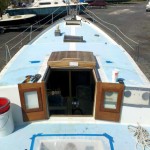














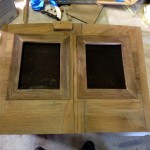
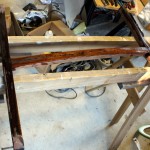
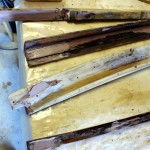
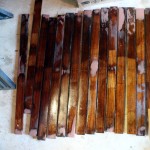

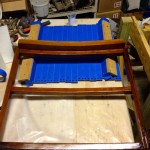


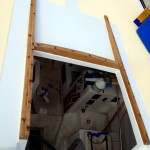
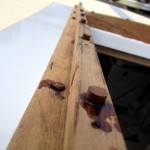


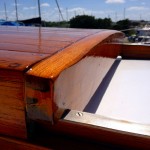
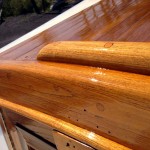
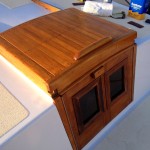

Recent Comments